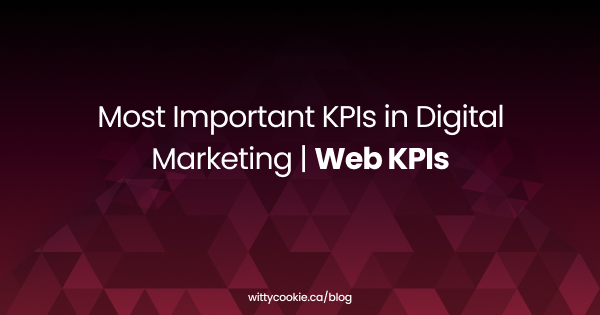Most Important KPIs in Digital Marketing | Web KPIs
Why Website Measurement Metrics and Web KPIs Are Important in Digital Marketing
To understand how your digital marketing efforts are performing and how you can improve them, you’ll need to regularly track and analyze the proper website measurement metrics of those campaigns. These digital marketing measurement metrics highlight the areas where your site, blog, or your online marketing campaign is doing well, what needs additional changes and amendments to be improved, and what should be scrapped entirely. Effectively measuring website performance is essential to creating and maintaining a good online presence.
How Website Key Performance Indicators Will Help Your Business
Understanding the correct website key performance indicators (KPIs) can help enable you to identify big problems such as poor timing, inconsistent search phrases, incorrect prospect definitions, and flawed audiences. Most importantly, it can help avoid wasting time and money due to poorly-executed websites or marketing campaigns. The tricky part is knowing the different types of metrics and how they affect your business.
Here is a list of different key performance indicators, metrics, and terms you can use to help you track, analyze, and improve your online marketing efforts, whether it’s for your online marketing and advertising campaigns, email marketing newsletters, etc. Basic metrics of website analytics and other important web KPIs include:
-
Google Ads Terms and Metrics
For online campaigns, one of the most important web KPIs in digital marketing are those used in Google Ads. Using Google Ads is a pretty easy and effective way to improve SEO. To use Google Ads effectively, you should be familiar with the following Google Ads terms:
- Click-Through Rate (CTR): This is the percentage of people who clicked on your advertisement. For example, a 5% CTR means five out of every 100 people who saw your ad clicked on it. For reference, an average CTR for e-commerce sites is 1% to 3%.
- Average Position: This tells you the placement of your ad in search results. Most retailers find positions three through five have the best results.
- Impression Share: This tells you how many times you ad shows up per number of searches made on a particular search phrase. For instance, if your impression share was 50%, that would tell you that your ad was displayed half the time. A strong impression share is generally about 80%.
- Bounce Rate: This tells you the percentage of people who clicked on your ad and went to your landing page but did not visit another page on your website. For example, a bounce rate of 30% means three out of ten people clicked on your ad and left after visiting your landing page. Generally speaking, having a lower bounce rate is better, but a bounce rate of 40% is considered a good rate.
- Conversion Rate: This tells you the rate at which visitors are converted into buyers. Typically, 1.25% is the low end for e-commerce sites while a 10% conversion rate is the ideal rate and is achieved by global advertisers.
For someone just starting out with Google Ads or web KPIs in general, there are many online resources to help you get started. Check out the training provided by Google – Skillshop, or this step-by-step tutorial by Santrel Media.
-
Email Marketing Metrics
For email campaigns, many key performance indicators and measurement metrics are named differently but mostly track the same things. It is useful to understand what the standards of these KPIs are in your industry so that you can have a more accurate comparative value to measure your own success rate. The email marketing metrics you should be familiar with are:
- Opens: This tells you how many recipients opened your email.
- Clicks: This tells you how many recipients clicked on the offers in your email.
- Bounces: An email usually gets “bounced” when it’s sent to an incorrect email address. If you are receiving a high number of bounces then you should check and verify the emails on your list.
- Non-responders: This tells you how many people did not open your email.
- Forwards: This tells you of how many people passed your email along to someone else.
-
Website and Blog Metrics
Using these blog and site metrics, you can track the number of visitors you have on your website, blog, or general landing page, as well as their behaviour and activities. Google Analytics supplies much of this information at no cost. The website metrics you should be familiar with are:
- Total Visits: This is the combined number of first-time visitors and returning visitors to your site.
- Unique Visits: This tracks the number of first-time visitors to your website
- Return Visits: This refers to the number of visitors who have previously visited your site before and are visiting again.
- Leads: This is the number of prospects who filled out a form or downloaded an offer on your site.
- Popular pages: This tells you which pages are getting the most visits. It is a good metric to see which pages are resonating best with your visitors as well as which pages aren’t.
- Search Engine Key Phrases: These are the top phrases people used to reach your site or landing page.
- Geographic Locations: This tracks which countries your visitors are coming from.
- Referring Websites: This shows you what external websites referred people to your site.
- Page Rank: This is a criterion created by Google. It refers to where your site appears on the search engine results page (SERP) and is one of the determining factors of a web page’s strength in search.
- Number of Inbound Links: These are links from other sites that refer users to your site.
Deciding which of these metrics you wish to analyze will depend on the campaign you are undertaking. Once you determine your methods and measurement KPIs, you should create a metrics report and begin to analyze them monthly. It is recommended that you monitor these metrics consistently so you understand the progress, success, and areas of improvement for your marketing campaigns to maximize your results.
Need professional help with Google AdWords? Check out WittyCookie’s Google Ad Services!



